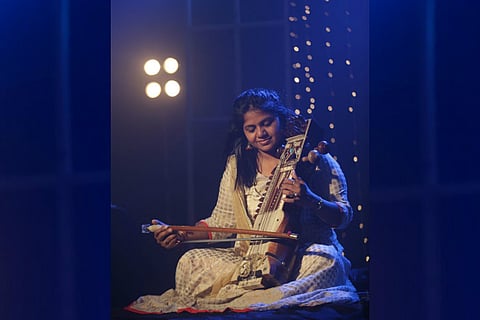

When AR Rahman composed the song Urvasi Urvasi in the 90s for the film Kadhalan, it revolutionised the Tamil cinema music landscape drastically. Everything about the song was refreshing – easy lyrics, breezy music along with refreshing visuals. Very soon, the song was a cult hit.
The song also popularised and gave a new sounding spin to an otherwise mellow sounding instrument. At about two minutes into the song, you groove to the classical notes of the dilruba, a bowed string instrument used majorly in Hindustani classical music. The instrument has very few players in the south and even less women who can play it.
If you pay close attention to today’s Tamil film songs, you will hear the unique tones of another bowed string instrument – the sarangi. Although it sounds very similar to the dilruba, the sarangi comes with its own tonality. And the fact that there are not many players of this instrument in the south makes it a rarity in Tamil film songs.
If you’re wondering what the sarangi actually sounds like, listen to the prelude to the song Embuttu irukudhu aasai (from Saravanan Irukka Bayamaen) or the interlude in Kooda mela kooda vechu (from Rummy).
Meet Manonmani, the first female sarangi player in south India, who played the instrument for both the above songs and more. Interestingly, Manonmani is the daughter of Saroja, the musician who played the dilruba in Rahman’s Urvasi.
TNM caught up with the upcoming musician on her love for music and her journey so far. Excerpts from the interview:
You come from a family of musicians. Your mother Saroja and your grandfather PV Shanmugam are both dilruba players. Did that inspire you to take up the sarangi
Actually, I began learning the sarangi only in 2009, out of my own interest. I began by watching videos online. Five years ago, I joined the Gurukulam of Ustad Ghulam Sabir Khan in Delhi and I’ve been training under him since.
Previously I learnt the dilruba and Carnatic music but I wasn’t encouraged to play in films by my family. Later, after I got married, I decided to learn and explore more out of my own interest.
What encouraged you to pick up this instrument in particular?
Many years ago, AR Rahman had gifted the Chinese erhu to my mother. I began playing the erhu first. I’ve played the instrument for Yuvan Shankar Raja for the song Ennamo nadakkiradhe (from Sandakozhi), Chellame Chellame (from Sathyam) for Harris Jayaraj and a few more. But somehow this instrument did not pick up too much in the industry, may be because it sounds very solemn. Then I picked up the sarangi and loved how it sounded.
What challenges did you face while learning this instrument?
The strings in the sarangi are held by the cuticles of your nails. So initially there is a lot of bleeding until the skin roughens. Also, the instrument is a very rare one in the south, there are not many who make it. An interesting thing about the sarangi is that the strings are made from goat’s intestines. The instrument I use was given to me by my guru and it’s more than 100 years old.
My husband has been very supportive of my interest. I also have a 12-year-old son… balancing both family and career has been easy because both of them are very supportive.
Did you ever feel pressure because you come from a family of musicians?
Well, the first time I played in front of AR Rahman, I was an amateur. I wasn’t serious about wanting to make a career in music and so things didn’t work out back then. Also, my family was not keen on me playing for films.
I’ve just begun playing in concerts and for films. After listening to my recent songs, Rahman sir called me for the Macho song in Mersal. I feel I’ve carved my own path here.
Film songs don’t have as many live instruments as they did before. How are you overcoming this challenge?
That’s true and also not many people have knowledge about how a particular instrument sounds. This gets a bit challenging when music directors expect a particular tonality out of an instrument. It’s not that it can’t be done… it is always interesting to overcome such challenges. The best thing about playing for films is that you get to experiment with different genres. One day it’s jazz, the next day it’s classical.